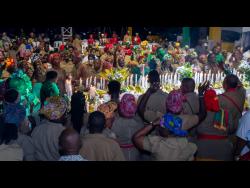The Crossroads of Faith: Christianity and African Spirituality in the West Indies
From Catholics to Baptists, various Christian denominations from Europe and America ventured to the West Indies with a singular mission: to Christianize and save the souls of the Tainos, the indigenous people, and the enslaved Africans on Jamaican plantations. This historical endeavor was rooted in the belief that salvation awaited those who embraced Christianity, but the narrative is far more complex and nuanced than mere conversion.
Many of the enslaved Africans and the Tainos did convert to Christianity, some even assuming roles as preachers and missionaries themselves. They carried the Gospel of Jesus Christ beyond Jamaica, reaching out to communities in America, other Caribbean nations, and even to Africa. Their enthusiasm in spreading the Christian faith was profound, yet it did not erase their rich spiritual heritage.
The Ban on Traditional Spiritual Practices
Under the rule of their enslavers, public expressions of African spiritual practices were condemned. The enslaved people’s spiritual rituals, often misunderstood as sorcery, were vehemently opposed by those who feared what they could not comprehend. This cultural disconnect paved the way for a spiritual tension that many enslaved Africans found challenging to navigate.
Despite the coercive pressure to abandon their ancestral beliefs, many enslaved individuals clung to their unique spiritual identities. In public, they appeared compliant, worshiping the Christian God, yet in the privacy of their lives, they maintained a connection to nature and sought counsel from ancestral spirits. This duality created a complex spiritual landscape, one that the colonizers could never fully understand.
The Emergence of Spiritual Communication
With no familiarity of Middle Eastern or European religious practices, the enslaved Africans forged their spiritual paradigms focusing on family connections, both earthly and ancestral. They nurtured relationships with loved ones who had passed away, venerating them as living spirits rather than distant memories. Rituals acted as vital media for spiritual communication, bridging the earthly realm and the spirit world.
Even after Emancipation, many freed people remained tied to the plantations, working under the same oppressors from whom they had just gained their freedom. Although drums and spiritual practices were still banned in public, this did not extinguish the enslaved people’s longing for their traditions. Their spirit remained undeterred.
The 1860-61 Spiritual Revival
It was in this environment of pent-up emotions and unexpressed beliefs that the dramatic Revival of 1860-61 erupted. Just 22 years after Emancipation, the ex-enslaved sought to reclaim their spiritual narratives, which had been stifled for so long. The Revival was a powerful collective outpouring where their cultural practices merged with Christianity, leading to what we now understand as Revivalism.
Emancipated individuals began utilizing the Christian church as a space that allowed them to mask their traditional beliefs in a new light. This led to the syncretization of African spirituality and European Christian philosophies, giving rise to a uniquely Jamaican form of worship. Jamaica’s Revivalism soon became a vibrant folk religion, deeply embedded in the cultural fabric of the island.
Revivalism and its Religious Ethos
Revival churches and their congregants stand apart from other branches of Christian faith in Jamaica. They are a significant segment of the nation’s religious ethos, visible in their unique practices and communal rituals. Recently, the ‘Revival Pilgrimage to Watt Town’ was inscribed on UNESCO’s list of Intangible Cultural Heritage of Humanity, recognizing its cultural significance.
The Revival Church offers a haven for individuals seeking self-expression through cultural artifacts often viewed with suspicion elsewhere. This stage becomes a space of self-liberation and empowerment, where congregants tell their stories of joy, sorrow, success, and tribulation through various mediums—ritual gowns, drums, and even spirit writing. Objects in this space facilitate a dialogue between the individual and their collective history, each piece carrying the weight of personal and communal experience.
The Legacy of African Spirituality in Jamaican Revivalism
In Revivalism – Representing An Afro-Jamaican Identity, the late Dr. Maria A. Robinson-Smith elaborates on how Revivalism emerged post-Great Revival, termed a “New World religion” influenced heavily by myalism and the Black Baptist movement. It represents more than just a religious practice; it is a vital aspect of the Jamaican psyche for many of African descent.
The Revival movement encapsulates the intertwining of African traditions and Christian beliefs, serving as a lasting legacy rooted in resilience and cultural identity. It emphasizes the importance of communal ties and individual expressions of faith, proving that the spirit of the ancestors continues to thrive in the hearts and minds of the Jamaican people.



